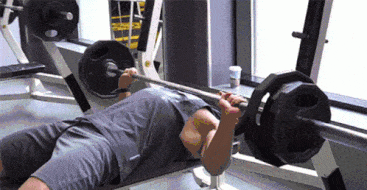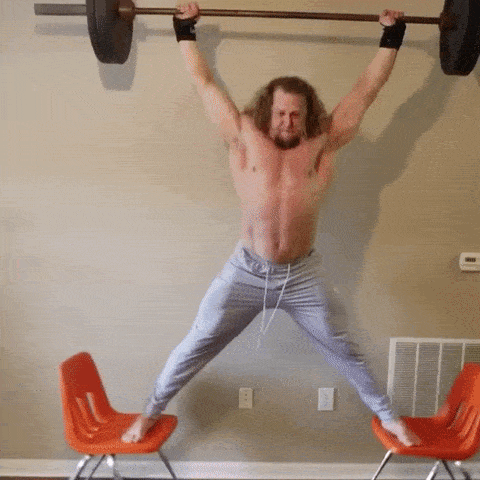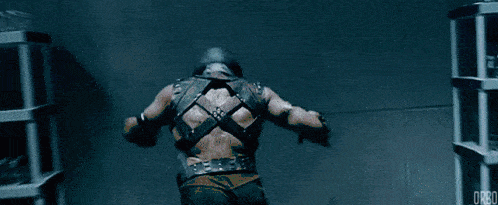Beginner hypertrophy programs are incredibly simple to set up.
If you’re not sure what hypertrophy is as a beginner that’s natural.
It’s basically just a fancy way to describe muscle growth. This means training for muscle hypertrophy is basically just building muscle.
Luckily, as a beginner, our bodies are in an untrained state, and it’s effortless for muscle growth to occur.
All you have to do is lift some weights, recover from it, and repeat.
So today, we’re going to go over the following:
- An ideal beginner hypertrophy program
- The best workout splits you can use
- How to write your own resistance training program
- The best compound exercises you should use
- Frequently asked questions that I hear quite often from you guys
- And more!
Let’s get started!
On This Page
Beginner Hypertrophy Program
For beginners, the best beginner hypertrophy program you can do is resistance training 3-4 times per week, slowly adding more weight over time, and trying to get stronger in the 5-20 rep range for the majority of your training.
That’s all you need to do for a very long time.
If you go from a 45 lb bench press for ten reps to 90 lbs for ten reps, you’ll get bigger and stronger.

Super easy, and it works much better than doing a ton of volume and sets, overcomplicating everything, and not recovering.
Remember, muscle growth doesn’t occur just from lifting weights; you have to recover from that resistance training too.
The worst thing you can do as a beginner is a ton of sets that you can’t recover from and don’t even need for muscle growth.
Basic Muscle Hypertrophy Program For Beginners
Here’s what you need to do as a beginner.
First, begin with straight sets of 5 for all of your exercises.
Don’t go to failure just yet, as you don’t need that stimulus as a beginner.
You can grow and get stronger with basic straight sets during a beginner program.
As I stated before, it’s so easy because your body is in an untrained state.
Any work you do will automatically force your body to change, build muscle, and even lose fat as you go through what’s known as body recomposition.
Until you start plateauing, add 5 lbs to each movement per week, do a set of 5 with great execution, and continue doing that.
I’ll tell you what you should do after you plateau in just a minute so keep reading.
After your compound exercises, you can throw in some work for the biceps, calves, and rear delts to fill in the gaps that compound movements leave behind.
Which compound movements should you be using?
You can check out my article on my top 10 exercises to get stronger for life, or read on as I’ll be going over them more right now!
Best Compound Exercises For Beginners
For those that don’t know, compound exercises are movements that train multiple muscle groups simultaneously.
The idea is that the more muscle groups work as a unit, the more muscle growth and strength you can gain by using them.
This is because it allows you to use the most weight and train more than one muscle group at once.

This is much more efficient than picking an isolation exercise for each muscle group.
So if you have to choose, especially starting out, you want to do a program with as many compound exercises as possible.
The best compound exercises for beginners are mostly going to depend on your individual structure.
In general, though, you mainly just need to try out a couple of basic exercises and see how you respond.
As long as progressive overload is happening, you’re on the right path.
You don’t need to change exercises every month or do anything fancy.
Compound Movements To Train The Entire Body
The best compound exercises for beginners that I’ve used with my clients are as follows.
- Upper Body Push
- Incline Bench Press/Dumbbell Bench Press
- Overhead Press/Seated Dumbbell Press
- Pushups/Dips
- Upper Body Pull
- Barbell Rows/DB Rows
- Neutral/Wide-Grip Pulldowns
- Inverted Rows/Pullups
- Squats/Single Leg
- Bodyweight Squats/Box Squats
- Barbell Squats
- Split Squats
- Lunges
- Hinge
- Trap Bar Deadlift
- Romanian Deadlift
- Back Extensions
These are all of the major exercises and movement patterns I recommend for beginner lifters.
The main thing is to pick 1-2 exercises from each movement pattern, get stronger at it for an extended period, and that’s it.
It doesn’t have to be any more complicated than that.
To see how I set up a progression for these, check out my Ultimate Push Pull Legs Workout Routine for a ton of information covering everything you need.
Beginner Workout Split
I‘ve gone over other workout splits in the past, such as push pull legs.
However, for beginners, there are two splits I recommend that you should do first.
The first is a full body beginner hypertrophy program, and the other is an upper/lower program that you can use once you get stronger.
I recommend full body muscle hypertrophy programs for beginners because you can stimulate more muscle growth early on to grow them faster.

Plus, since you’re only doing 1-2 sets for each muscle group, you can push hard and recover quickly since you have less muscle mass.
The more muscle mass you have, the longer it takes to recover from training.
This is when you would want to switch to an upper-lower split and then eventually push pull legs.
I’ll go over an upper-lower split later on, but if you want to learn more about push pull legs, this article covers everything.
Full Body Hypertrophy Plan For Beginners
Here’s how I usually set up a full body training program that works every single time.
“A” Day
- Barbell Squat/Goblet Squat
- Incline Bench Press
- Neutral-Grip Pulldown
- Close-Grip Pushups
- Back Extensions
“B” Day
- Romanian Deadlift/Dumbbell RDL
- Seated Dumbbell Press
- Barbell Row/Chest Supported Row
- Barbell Curls
- Split Squats/Lunges
Each day is super easy to figure out and implement.
You set up two different whole body workouts and rotate through them.
The cool thing is, you can use this 2-4 times per week as long as you’re recovering.
You don’t have to think about anything except working hard, eating enough calories and protein to grow and recover from your workouts.
If you’re curious if you need protein powder to build muscle, this guide will help you out.
By doing this, you’ll build muscle mass more than in other resistance training programs such as starting strength or beginner strength programs.
For each workout, you’re using one exercise for each major muscle group and rotating through.
This way, each muscle group gets its emphasis each week, and not a ton of overlap occurs.
Next, I’ll show you how to write a program for yourself as you get more knowledgeable about your own body and what it needs to grow.
How To Write Your Own Program
Learning to set up your own program is something everybody is forced to do at one point or another.
Following other people’s muscle hypertrophy programs for a while is absolutely fine as you learn basic concepts such as progressive overload, proper recovery, and of course, how to perform exercises correctly.
I always tell people that if they’re making progress and they feel great, not to change anything.
The worst thing you can do is go week after week crushing PRs and changing something simply because Athlean-X told you so.
Seriously, Instagram and YouTube training isn’t “REAL” training, guys.
It’s meant to sell things and look like the next big thing.
In reality, actual hard and heavy resistance training has and will continue to work forever.
That means sets of 5-20 reps. That’s all you need, and everything else is just extra noise.
If you aren’t stronger now than you were six months ago, then you’ve done something seriously wrong.
But let’s get back on topic.
Building and writing your own beginner hypertrophy program is incredibly simple.
Hypertrophy Workout Template
For a full body program, this is the template you would use.
“A” Day
- Squat Variation
- Horizontal Push Variation
- Upper Back Variation
- Tricep Compound
- Low Back/Hamstring Variation
“B” Day
- Hinge Variation
- Vertical Push Variation
- Lat Variation
- Curl Variation
- Quad/Single Leg Variation
This template is super easy to set up and has absolutely zero fluff in it.
You train each and every muscle group each workout, get stronger, and work hard.
That’s all you have to do for muscle growth to occur, especially as a beginner.
If you wanted to add more work in for your calves or rear delts, you definitely can.
But for most people, just doing the compound basics and getting stronger at them is all you’ll need.
For taller guys, you should absolutely train biceps and triceps directly as I’ve found they need the extra work to actually grow.
If you have any questions on this template or you want to add anything to it, definitely let me know in the comments below, and I’ll help you out!
How Do I Get Past A Plateau In Muscle Building?
After a while of running this program, you’re bound to hit a plateau eventually.
Many training programs neglect to inform you, especially as a beginner, how to get past these plateaus.
They tell you all the sets and reps to use, the exercises, and what supplements to take, but neglect this critical part of training.
If plateaus didn’t exist, everybody that ever worked out for a couple of months would be benching, squatting, and deadlifting massive weights.

As many others and I have found, the harder you push into a plateau, the harder the rebound is.
If you keep trying to do more reps and add weight regardless of what your technique looks like, you’re going to get injured.
If you get injured, you have to rehab the injury and hope it doesn’t happen again in the future.
Staying injury-free is hard work, but if you take the time to listen to your body, you’ll be able to train harder for longer.
Trust me, when you get older and can still keep kicking ass in the gym, you’ll thank yourself for the lack of aches and pains you’ll have.
Now, moving on…
Option 1 – Back The Weight Off
When you hit a plateau on any exercise, you have a couple of options, the first is to just back the weight off by 10-20% and work back up by hitting new PRs.
Here’s how this might look for the Incline Press.
- Incline Bench
- Week 1 – 200×5
- Week 2 – 205×5
- Week 3 – 210×5
- Week 4 – 215×5
- Week 5 – 220×3
Since you finally stopped hitting your set of 5, you have two options.
You can back the weight off as I stated above, or you can try the same weight again and see if you just had an off day.
It’s also possible you didn’t sleep and eat enough.
If you choose to go for the latter, do the same weight, and if you hit 5 reps, add weight the following week and keep going.
Eventually, you’re going to get to a weight that you’ll fail to hit multiple weeks in a row for your prescribed 5 reps.
Once this happens, you should definitely back the weight off.
- Let’s say this weight for you is 240 lbs on the Incline Bench.
- Subtract 10-20% from this and start progressing from there as you continue.
- 240×10%=216
- So round it down to around 215 and keep progressing from there up until your plateau.
Option 2 – Back-Off Sets
There’s also another option called back-off sets that you can start incorporating.
Back-off sets are simply another way to add more volume, which will give you an extra stimulus to continue getting stronger.
Remember, you’re just starting out and want to make sure your technique is always on point.
If you can only do sets of 5 on the Deadlift or your back will start rounding, do sets of 5 for your back-off sets as well.
Here’s how this would look on the Squat!
- Barbell Squat
- Week 1 – 250×5, 225×5-8
- Week 2 – 255×5, 230×5-8
- Week 3 – 260×5, 235×5-8
Super easy, and it’ll extend your beginner hypertrophy program for a while.
Unfortunately, if this was all that is required to train forever, there wouldn’t be tons of Instagram coaches out there making a killing.
So what do you do when you plateau multiple times and just can’t break past certain weights?
You can either change exercises to something different or move on to an intermediate hypertrophy training program!
If you choose to change exercises and start with a lighter weight, you definitely can.
However, I recommend moving on to the program below to make better use of your time and accelerate your progress.
Let’s get into it!
Best Hypertrophy Program For Intermediate Lifters
The intermediate hypertrophy program I’m going to lay out is a direct extension of the beginner hypertrophy program I laid out above.
Everything can remain the same except how the sets will be performed.
Since you now have a couple of months or more of training under your belt, your technique should be spot-on for the most part.
As long as that is the case, you should be able to run this program with no problem.
Basically, you take the framework from above and push your top set close to or to failure.
So instead of bench pressing for a set of 5, you would push it until you’re at mechanical failure.
Basically, when your form breaks down, the set is over.
The best way to build muscle mass is by increasing the intensity over time to force your muscles to grow.
This is a much better long-term strategy than simply doing more volume.
If you go from 10 sets of the chest to 20 sets of the chest over multiple weeks, the only thing that has to change is you have to be in the gym longer.
An extra set might take 2 to 5 minutes to do, but that doesn’t mean that the extra set will contribute to building more muscle fibers.
It might just make you more fatigued and dig into your recovery.
Plus, it just means more time in the gym and less time living life.
However, increasing your squat from 200×10 to 300×10 requires adaptations in your body to occur.
Including, of course, muscle growth.
This is an easy-to-understand concept, which is the sole driver for this program.
You don’t have to do anything but get stronger on a couple of basic exercises.
As long as you’re making progress on whatever movements you select, stick with it.
That is all.
Rules To Follow For Intermediate Hypertrophy Program
Here’s how to set this up!
- Pick any of the rep ranges you want to work in for each exercise.
- You can use 5-8 for basically everything if you want to keep it simple.
- As long as you hit 8 reps or more, you can add weight. However, don’t stop at 8 reps if you can do more. This is an important distinction that you need to pay attention to.
- Train harder than you did last time to continue making muscular gains into the future.
Here’s how this might look for the Romanian Deadlift.
Romanian Deadlift
- Week 1 – 200×8
- Week 2 – 205×8
- Week 3 – 210×7
- Week 4 – 210×8
- And so on…
As you can see, as long as you hit 8 reps, add 5 lbs the following week and push close to failure again.
In week 3, we only hit 7, so we keep the same weight in week 4 and finally hit 8.
Then, you can move on to 215 the following week and push hard again.
This is all that’s required for muscle growth to occur.
You can add sets once you start plateauing like in the beginner program, but that’s outside the scope of this article.
Frequently Asked Questions
Conclusion
Now I turn it over to you!
Do you have any questions on how to train as a beginner?
Also, what tips from this article are you going to use to build the most muscle possible?
Let me know in the comments below!
Until next time,
-Dante Redgrave